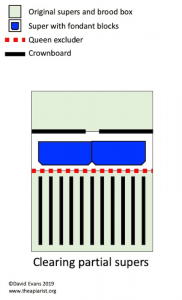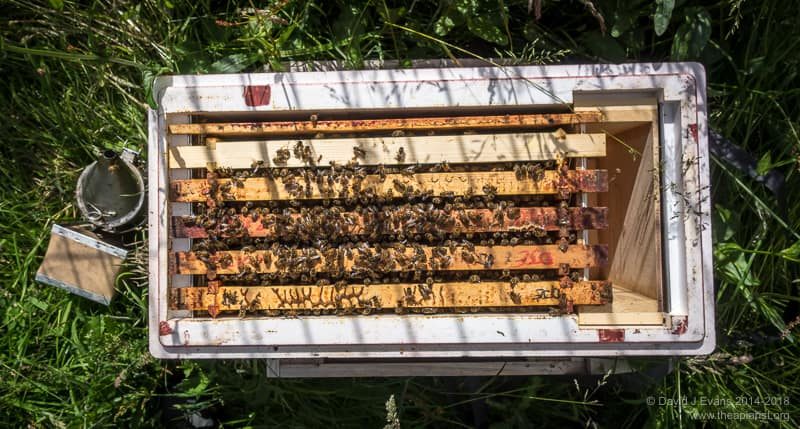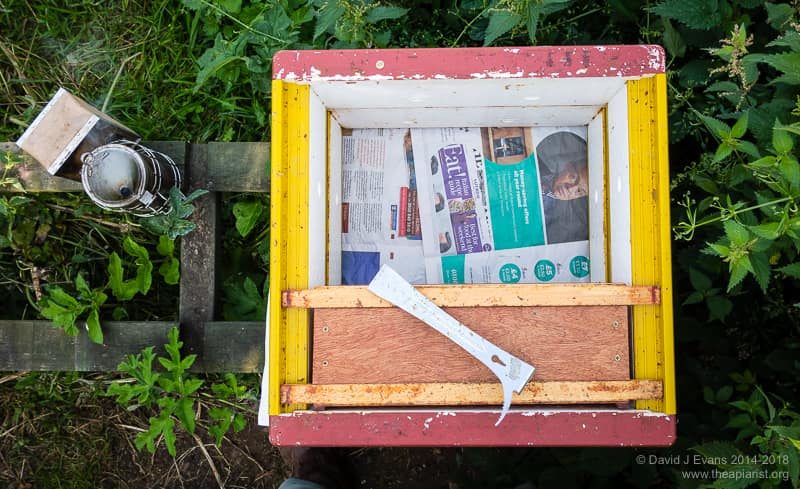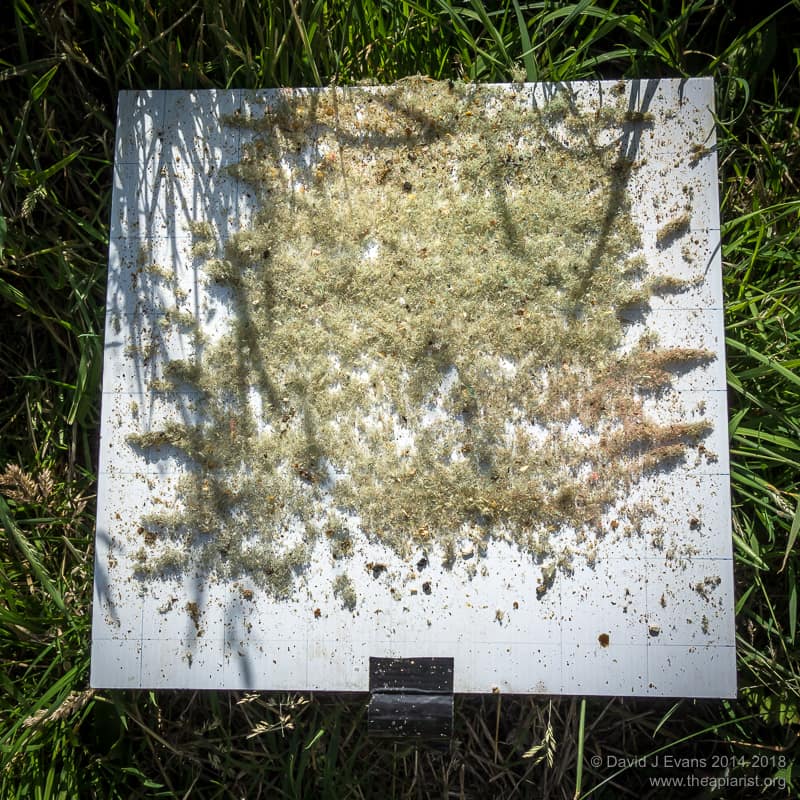Cabinet reshuffle
Don’t worry, this isn’t a post about the totally dysfunctional state of British politics at the moment {{1}}.
Once the honey supers are removed there’s seemingly little to do in the apiary. There is a temptation to catch up on all those other jobs postponed because I was “just off to the bees”.
Well, maybe temptation is a bit strong. After all, like all good procrastinators, I can usually find an excuse to postpone until next week something that could be left until at least tomorrow.
However, as I said last week, preparations for winter are very important and should not be delayed.
I covered feeding and the all-important late summer mite treatments in that post. Here I’m going to briefly discuss the various late season hive rearrangements that might be needed.
Clearing additional supers
I use very simple clearer boards to get the bees out of my supers. However, there are a couple of instances when not all the supers end up being removed:
- If some frames are empty or fail the ‘shake test’ I’ll rearrange these into the bottom super {{2}}. I then clear the bees down into the bottom super and leave it for the bees.
- If the colony is really strong and is unlikely to fit into the brood box(es) I’ll often add a super above the queen excluder to clear the bees down into. Sometimes the bees will add a few dribbles of nectar to this … not enough to ever extract, and I’d prefer they put it in the brood box instead.
In both these situations I’ll want to remove the additional super before winter. I don’t want the bees to have a cold empty space above their heads.
I usually do this at the same time that I feed the bees.
I rearrange the boxes so that the ‘leftover’ super is above a crownboard on top of the super that is providing the headspace to accommodate the fondant blocks.
Since access to this top super is through a small hole the bees consider it is ‘outside’ the hive and so empty the remaining nectar and bring it down to the brood box {{3}}.
If there are sealed stores in any of these super frames I bruise {{4}} the cappings with a hive tool and they’ll then move the stores down.
Substandard colonies
A very good piece of advice to all beekeepers is to “take your winter losses in the autumn”. This means assess colonies in the late summer/early autumn and get rid of those that are weak or substandard {{5}}.
Substandard might mean those with a poor temper.
This is the colony which you put up with all season (despite their yobbo tendencies) because you believe that ‘aggressive bees are productive bees’.
Were they?
Was that one half-filled super of partially-capped honey really worth the grief they gave you all summer?
Unless substandard (not just aggression … running, following, insufficiently frugal in winter etc.) colonies are replaced the overall standard of your bees will never improve.
I’ll discuss how to ‘remove’ them in a few paragraphs.
It’s probably a reasonable estimate to suggest that the ‘best’ third of your colonies should be used to rear more queens and the ‘worst’ third should be re-queened with these {{6}}.
Over time {{7}} the quality will improve.
Of course, a substandard colony might well make it through the winter perfectly successfully. The same cannot be said for weak colonies.
TLC or tough love?
At the end of the summer colonies should be strong. If they are not then there is probably something wrong. A poorly mated queen, an old and failing queen, disease?
The exception might be a recently requeened colony or a new 5 frame nuc.
Colonies that are weak at this stage of the season for no obvious reason need attention. Without it they are likely to succumb during the winter. And they’ll do this after you’ve gone to the trouble and expense of feeding and treating them … {{8}}
There are essentially two choices:
- Mollycoddle them and hope they pick up. Boosting them with a frame or two of emerging brood may help (but make sure you don’t weaken the donor colony significantly). Moving them from a full hive to a nuc – preferably poly to provide better insulation – may also be beneficial. In a nuc they have less dead space to heat. An analogous strategy is to fill the space in the brood box with ‘fat dummies‘ or – low-tech but just as effective – a big wodge of bubble wrap with a standard dummy board to hold it in place.
- Sacrifice the queen from the weak hive and unite them with a strong colony.
Sentimentalism
Of the two I’d almost always recommend uniting colonies.
It’s less work. There’s no potentially wasted outlay on food and miticides. Most importantly, it’s much more likely to result in a strong colony the following spring.
However, we all get attached to our bees. It’s not unusual to give a fading favourite old queen ‘one more chance’ in the hope that next year will be her last hurrah.
Uniting notes
I’ve covered uniting before and so will only add some additional notes here …
- You cannot generate a strong colony by uniting two weak colonies. They’re weak for a reason. Whether they’re weak for the same or different reasons uniting them is unlikely to help.
- Never unite a colony with signs of disease. All you do is jeopardise the healthy colony.
- Find the queen and permanently remove her from the weak or poor quality (substandard) colony.
- If you can’t find the queen unite them with a queen excluder between the colonies. In my limited experience (I usually manage to find the unwanted queen) the bees usually do away with a failing queen when offered a better one, but best to check in a week or so.
- I generally move the de-queened colony and put it on top of the strong queenright colony.
- Unite over newspaper and don’t interfere with the hive for at least another week.
- You can unite one strong colony and two weak colonies simultaneously.
- Uniting and feeding at the same time is possible.
- You can unite and treat with a miticide like Amitraz simultaneously. You will have to make a judgement call on whether both boxes need miticide treatment, depending on the strength of the weak colony.
- If you’re uniting a strong substandard colony and a strong good colony you will need to use an amount of miticide appropriate for a double brood colony (four strips in the case of Amitraz).
Season of mists and mellow fruitfulness
The goal of all of the above is to go into autumn with strong, healthy, well-fed colonies that will survive the winter and build up strongly again in the spring.
A very small or weak colony {{9}} in autumn may survive, but it’s unlikely to flourish the following spring.
“It takes bees to make bees.”
And a weak colony in spring lacks bees, so cannot build up fast.
In contrast, an overwintered strong colony can often yield a nuc in May the following year. You’ve regained your colony numbers, but have a new, young queen in one hive with most of the season ahead for her to prove her worth.
I’ve merged three topics here – clearing supers, stock improvement and getting rid of weak colonies before winter – because all involve some sort of hive manipulation in the early autumn. I usually complete this in late September or early October, with the intention of overwintering strong colonies in single brood boxes packed with bees and stores.
Colophon
The heading of the final paragraph is the opening line of To Autumn by John Keats (1795-1821). Keats wrote To Autumn exactly two hundred years ago (September 1819, his last poem) while gradually succumbing to tuberculosis. Despite this, and his doomed relationship with Fanny Brawne, the poem is not about sadness at the end of summer but instead revels in the ripeness and bounteousness of the season.
Of course, all beekeepers know that the first stanza of To Autumn closes with a reference to bees.
Season of mists and mellow fruitfulness,
Close bosom-friend of the maturing sun;
Conspiring with him how to load and bless
With fruit the vines that round the thatch-eves run;
To bend with apples the moss’d cottage-trees,
And fill all fruit with ripeness to the core;
To swell the gourd, and plump the hazel shells
With a sweet kernel; to set budding more,
And still more, later flowers for the bees,
Until they think warm days will never cease,
For summer has o’er-brimm’d their clammy cells.
{{1}}: Joseph de Maistre (1753-1821) said “Toute nation a le gouvernement qu’elle mérite” (Every nation gets the government it deserves) but surely we deserve better than this?
{{2}}: They’re usually already in the bottom super as I always add new supers at the bottoms of the stack.
{{3}}: I’m ashamed I even wrote that sentence … I’ve no idea what the bees think about this super over their heads. They might not consider it’s outside the hive at all. They might just think it’s too far away. Whatever they think – if they think at all – the consequences are that they usually promptly empty it.
{{4}}: Just run the flat of a hive tool over the cappings and gently squash them down. You don’t damage the comb enough that honey drips out, but sufficiently that integrity of the capping is compromised.
{{5}}: In practice I try and deal with substandard colonies throughout the season. Usually by July I know they’re not good enough and I’ll start dealing with them then.
{{6}}: This sentence implies that you have at leat three colonies. You should have at least two. If you’re worried you don’t have a big enough pool to select from then work together with friends or your association.
{{7}}: And not actually all that long.
{{8}}: Admittedly not hugely expensive, but – being weak – they’re unlikely to have produced any honey, or done much pollination, so they’re hardly “paying their way”.
{{9}}: These are not necessarily the same thing at all. I’ve successfully overwintered mini-mating nucs containing less than 1000 bees with a cluster the size of a small orange. These are small, but they are not weak.




Join the discussion ...